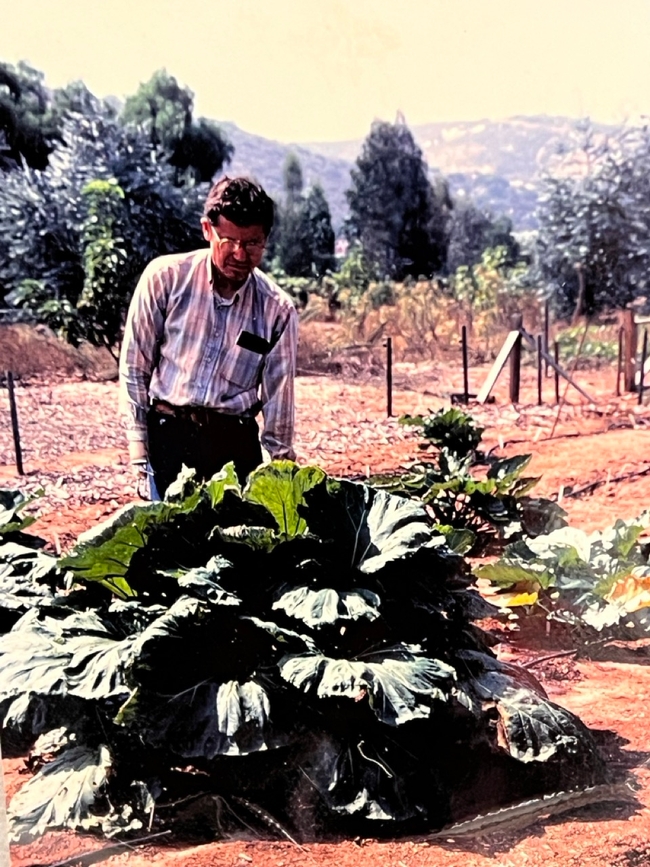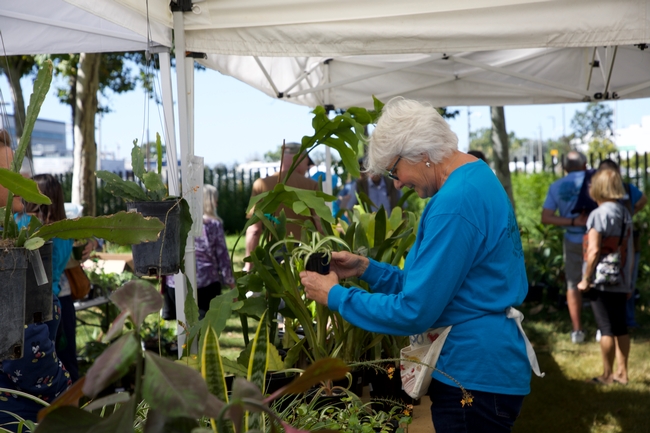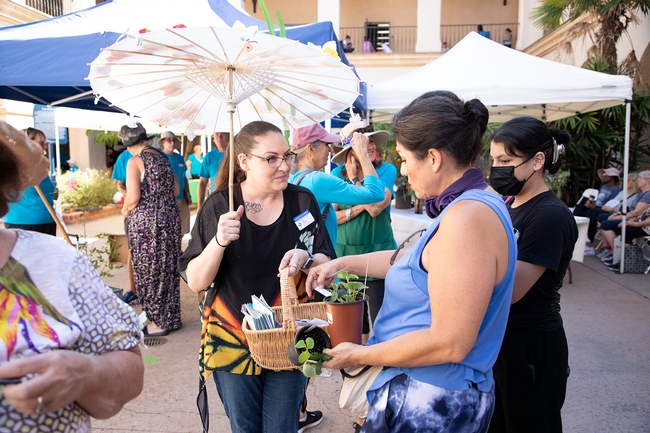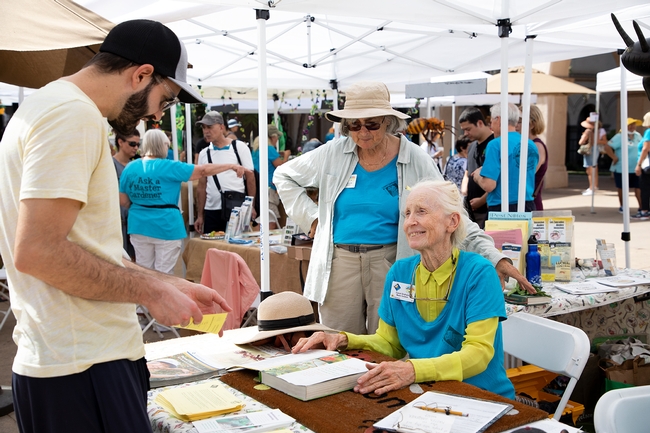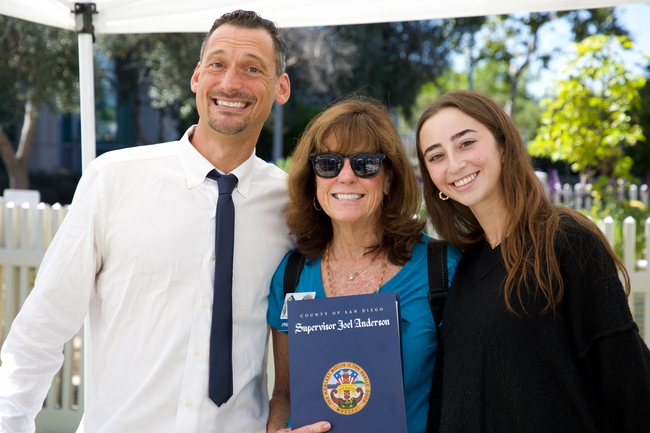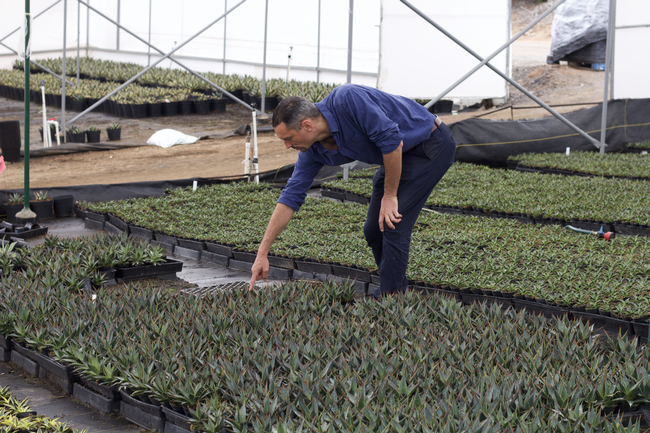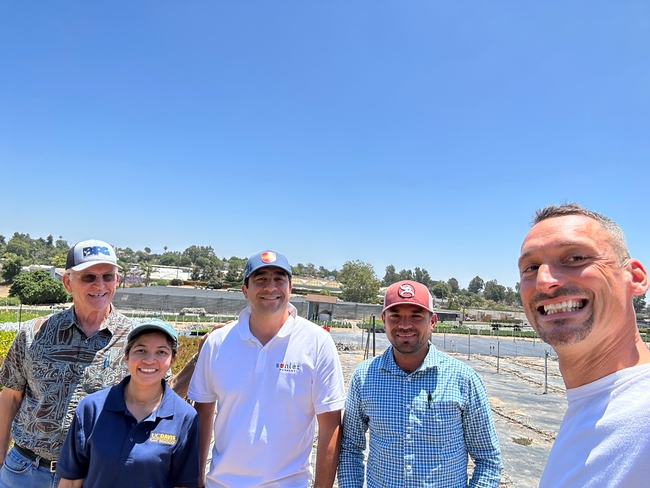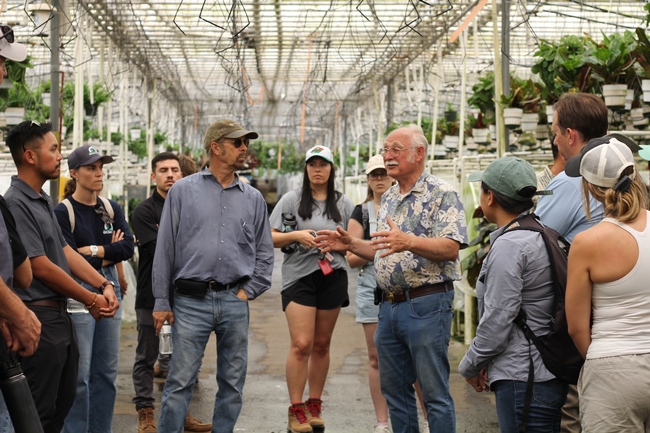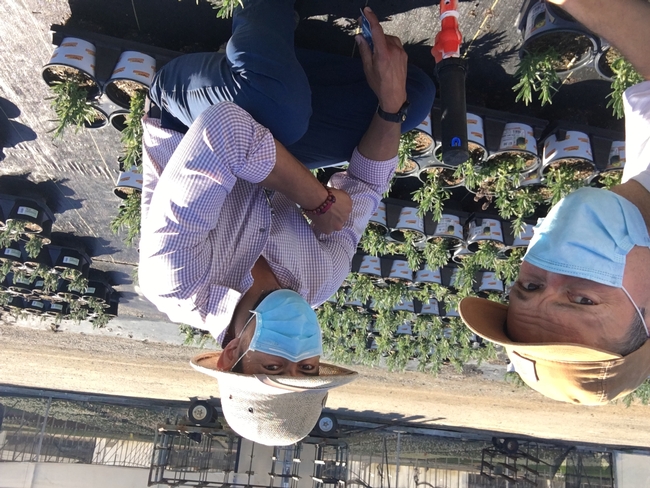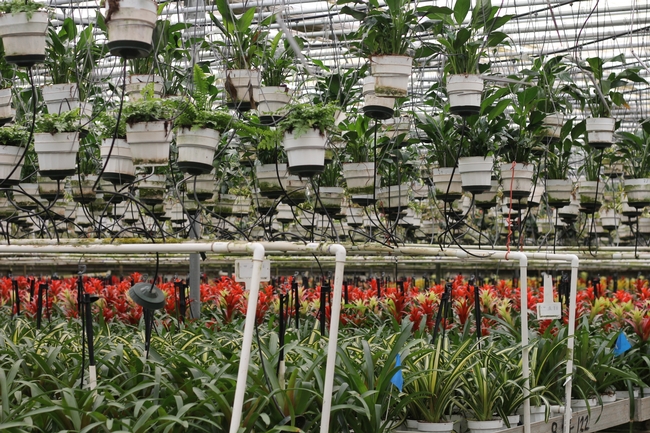Posts Tagged: Spinelli
UC Master Gardeners of San Diego celebrates 40 years of service to community
For 40 years, the University of California Master Gardener Program of San Diego County has upheld its mission of providing research-based information about home horticulture and pest management to the public, while earning and sustaining the community's trust in doing so.
“People trust UC Master Gardeners to provide accurate advice on gardening because they are trained by UC ANR [UC Agriculture and Natural Resources],” said Vincent Lazaneo, emeritus urban horticulture advisor and the first UC Master Gardener program coordinator for San Diego County.
The UC Master Gardener program, a public service and outreach program under UC ANR, is administered by local UC Cooperative Extension offices and outreach is provided by trained volunteers. In 1983, the UC Master Gardener program of San Diego County started with about 30 volunteers. Today, more than 350 volunteers serve the program, which is now managed by program coordinator Leah Taylor.
In San Diego, UC Master Gardeners have had a significant presence in schools, where they encourage an appreciation for plants and our planet; at the county fair where they field hundreds of questions related to plant care; and in community spaces such as Balboa Park and the Carlsbad Flower Fields where they staff demonstration gardens.
“Having the UC behind us is huge,” said Anne Perreira, UC Master Gardener and current president of the Master Gardener Association of San Diego County. “It opens doors for us and gives us credibility.”
'Dual citizenship' status expands capacity for support
When Lazaneo started the UC Master Gardener program in 1983, he felt the need to establish a formal association or 501(c)(3) nonprofit organization that would support the program.
Unsure of what the future held, Lazaneo believed that nonprofit status would increase the UC Master Gardeners' flexibility regarding project development, community engagement and financial planning. After 10 years, the UC Master Gardeners of San Diego County were approved as a registered nonprofit organization and became simultaneously known as the Master Gardener Association of San Diego County.
“It can be confusing for people when they hear that we're a UC program and an association,” explained Taylor. “It's like ‘dual citizenship' in a way, and I think the most important thing to know is that our status as a nonprofit and affiliation to UC work in conjunction to not only support the UC Master Gardeners and what they do in San Diego, but their ability to support UC Master Gardener programs in other counties.”
Emphasizing the research-based approach
Taylor, who has been the program coordinator since 2021, said that the UC Master Gardener program is instrumental in extending the work of UCCE advisors. “If you're working on research and you need to get that information out into the public, we've got 350 UC Master Gardeners who are trained and available to communicate on your behalf,” Taylor said.
“For me it's like a multiplier effect: how many San Diegans can I reach by teaching a seminar on small-scale hydroponics? Maybe 20 or 30,” said Gerry Spinelli, UC Cooperative Extension production horticulture advisor for San Diego County. “But how many can I reach by training 20 or 30 UC Master Gardener volunteers on the same topic? Maybe 200 or 300.”
Spinelli, who also advises the UC Master Gardeners for San Diego County, said that the group has been instrumental in data collection and disseminating information to the public, particularly in urban underserved areas.
Lazaneo recalls the UC Master Gardeners establishing a partnership in 1983 with Cuyamaca College in El Cajon. The college's Horticulture Department allowed the UC Master Gardeners to develop a research garden on campus. After setting a perimeter, building a fence, installing irrigation lines and rototilling the soil, the UC Master Gardeners planted different tomato varieties that were used in a statewide study assessing plant performance for home gardens.
In addition to educating and equipping the public, the UC Master Gardeners of San Diego County have contributed to research efforts on specific crops, including the development of a new artichoke variety, Imperial Star, with guidance from Wayne Schrader, former UCCE vegetable crops advisor for San Diego County.
The research garden, which was used for more than a decade, also aided in research efforts evaluating asparagus varieties, horned cucumbers called “Kiwano,” a fruit similar to melon called pepino dulce, sweet peas, rhubarb and many others. Similarly, the research garden has contributed to trials for soil solarization and chemical treatment to control root knot nematodes and expanded understanding of powdery mildew's impact on summer squash.
Evolving with the times
Out of 170 applications, Lazaneo selected about 30 individuals to be a part of the first class of UC Master Gardeners for San Diego County. Carol Graham, who is still active today, was in the original cohort that formed in 1983.
Graham said that “times have certainly changed,” and one of the changes she's noticed since joining UC Master Gardeners is the proliferation of insects. “I don't remember pests being a severe issue when I first started. Now, you've got all kinds of bugs that have moved into the county, causing people to overuse and misuse pesticides,” said Graham.
Graham's 40 years as a UC Master Gardener have given her an opportunity to teach people how to overcome their phobias of bugs and how to use pesticides safely and appropriately. Furthermore, her role as a UC Master Gardener has allowed her to teach others how to grow their own food in hopes of enhancing food security in the county, something she cares deeply about.
The UC Master Gardeners also have changed the way they communicate over the years. DeLayne Harmon, vice president of member services, is well-versed in the program's history.
“Before we began tracking our volunteer hours online, do you know what the UC Master Gardeners did back in the day?” asked Harmon, who joined UC Master Gardeners in 2020. “They wrote everything down by hand, with pen and paper!”
“It's easy to have the mentality that's like, ‘This is how we've always done things,'” said Harmon. “But the UC Master Gardeners know that there is always room for improvement, and we welcome opportunities to be better.”
Giving back and putting people first
The UC Master Gardeners of San Diego County are eager to improve access to fresh food in schools. Recently, the UC Master Gardeners were given a $5,000 grant by the Sage Garden Project, which will be used to partner with schools in under-resourced communities.
“We want to be in places where the people don't know about UC Master Gardeners,” said Perreira, the association president. “We realized that there are a lot of students who don't know what fresh food looks like and we want to change that.”
In 2022, the UC Master Gardeners transformed a landfill into a demonstration garden, now called the Paradise Hills Native Garden, which they also maintain. “It's beautiful and there are walking trails for the community to enjoy,” Taylor said. “The native garden is in a neighborhood that doesn't have a lot of green space, and to have something so beautiful, that encourages community gatherings, it's a good thing.”
Looking to the future of the UC Master Gardener program in San Diego, Taylor says that she wants to continue making an impact in the community and having the UC Master Gardeners be that driving force.
Grateful for Taylor's leadership, Spinelli said that he is excited about the program's impact on food education, particularly in food deserts.
“We are blessed with a climate that allows year-round food production, and with the science-based knowledge offered by the UC system, our UC Master Gardeners can provide San Diego County residents with the tools to grow local, healthy, nutritious, safe and environmentally friendly food for their families,” Spinelli said.
When reflecting on how far the UC Master Gardeners of San Diego County have come, Perreira – who has been a UC Master Gardener since 2016 – emphasized how important it is to continue their legacy of doing good in and with the community. “We've got a diversity of skills within our group and I'm ready for us to expand our capacity to create change. What we do and what we say have to mean something!” she said.
To read this story in Spanish, visit: https://ucanr.edu/blogs/blogcore/postdetail.cfm?postnum=59028
UCCE San Diego advisor educates growers on complex water regulations
‘Ag Order' for San Diego County expected to be enforced by end of 2023
Generally known for its steady warmth and picturesque beaches, San Diego County is also home to nearly 5,000 small farms and is an economic hotspot for nurseries and floriculture. But the great diversity of ornamental crops that dominate the growing region and complexity of regulations make compliance challenging for growers, some of whom grow over 400 crop varieties.
“The regulatory environment for the growers is still complicated and overwhelming because, along with the Regional Water Board, growers are regulated by the County of San Diego,” said Gerardo “Gerry” Spinelli, University of California Cooperative Extension production horticulture advisor for San Diego County.
To help growers with compliance, Spinelli is prioritizing education and expanding growers' knowledge. By partnering with organizations such as the Farm Bureau of San Diego County and the San Diego Region Irrigated Lands Group, Spinelli works to reach more than 1,200 growers, supporting them as they navigate regulatory agencies.
Formally referred to as the Regional Water Quality Control Boards, the Regional Water Board aims to develop and enforce water quality objectives and implement plans to protect the beneficial uses of California's waters.
A unique place to grow in California
About 10 years ago, the Regional Water Board created the Agricultural Order (Ag Order), a set of rules outlining how growers manage water discharge from agricultural operations.
The new Ag Order for San Diego County, expected to be enforced by the end of 2023, will focus on nitrogen management and groundwater quality. However, new considerations are needed to address the variety of crops grown by a single farmer, a common practice in San Diego.
Calculating nitrogen input and output for more than 400 crop varieties is not feasible for small farmers, a challenge exacerbated by the meticulous attention needed for San Diego's high-end specialty crops like ornamentals, native plants and specialty fruit.
Furthermore, many San Diego growers have limited expertise and experience because they are entering agriculture as a second or third career. Many have become “accidental growers” in that they purchased land with a preexisting avocado or cherimoya grove, for example.
To help address these challenges, the grower community is emphasizing the need for more educational opportunities that are accessible and relatable.
Equipping growers through education
Enrico Ferro, president of the San Diego Region Irrigated Lands Group – a third-party entity that manages water sample testing on behalf of growers – has relied on Spinelli's teaching to “bridge the gap” for growers, including himself.
“Gerry has been great because he has expertise in nurseries, but the educational content he creates is relevant to all growers,” said Ferro, who is an avocado and citrus grower in San Diego's North County.
Spinelli, who specializes in containerized production in nurseries and floriculture, has been instrumental in providing technical assistance to growers since he joined Cooperative Extension in 2020.
“I started teaching over Zoom since I became an advisor during the pandemic, and I try to cover different topics for each training,” Spinelli said, adding that he teaches in English and Spanish, making his content more accessible to the grower community in San Diego.
For in-person educational opportunities, Spinelli created the “Last Wednesday” monthly meetings hosted at the Farm Bureau of San Diego County, which brings together growers and other agricultural experts to learn from one another.
“We try to get our information out in creative ways and Gerry is instrumental in that. He's our primary source of really wonderful information delivered in an engaging way,” said Tasha Ardalan, program coordinator for the SDRILG. “He's proactive and is always willing to try new things, too.”
Planning for San Diego's agricultural future
Currently, the Ag Order is modeled around regulations for the Central Valley. As conversations and planning for San Diego County continue, Spinelli is supporting the Regional Water Board with information on nurseries and greenhouses in hopes that the final Ag Order will better serve San Diego growers.
“I'm trying to help others understand how nursery and greenhouse production systems function, and how and why they are different from an almond orchard or tomato field in Fresno,” explained Spinelli.
Michael Mellano, CEO of Mellano & Company, a fresh cut flower grower and distributor in Oceanside, feels the impact of the Ag Order and its failure to account for variability. Growing over 100 varieties of flowers, Mellano said that for several plants there is little scientific research on how much nitrate to apply.
“Farmers want to do a good job. We make mistakes and we try to fix them as quickly as we can, and we try to educate others on what works,” said Mellano, who is also a member of the SDRILG.
Growers like Mellano and Ferro agree that the farming community in San Diego needs to be given the latitude to solve problems within their means, an ability that requires an understanding of San Diego's uniqueness.
“San Diego is significantly different, and we need an Ag Order that is reflective of our differences,” said Valerie Mellano, SDRILG consultant and former UCCE environmental issues farm advisor. “In developing the new Ag Order, there's a huge opportunity for education and research, something that we know Gerry can easily do and continue to support us in.”
Thus far, Spinelli's educational content has reached two-thirds of SDRILG's 1,200 members. In addition to the live training sessions, growers can watch videos that cover topics such as evapotranspiration, irrigation distribution uniformity, water quality indicators and more on Spinelli's YouTube channel.
Since the Ag Order requires all growers to complete two hours of water-quality education, the SDRILG has agreed to apply one hour of credit to growers who attend a one-on-one session with Spinelli.
As San Diego's growers continue to leverage educational opportunities – whether it's alongside Spinelli, SDRILG or learning from one another – Spinelli emphasized that their success also relies on an ag order that adheres to a distinctive landscape, multitude of specialty crops and growers with varying expertise.


